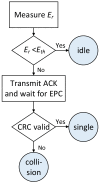Protocol for Streaming Data from an RFID Sensor Network †
- PMID: 31319589
- PMCID: PMC6679319
- DOI: 10.3390/s19143148
Protocol for Streaming Data from an RFID Sensor Network †
Abstract
Currently, there is an increasing interest in the use of Radio Frequency Identification (RFID) tags which incorporate passive or battery-less sensors. These systems are known as computational RFID (CRFID). Several CRFID tags together with a reader set up an RFID sensor network. The reader powers up the tags' microcontroller and their attached sensor using radio frequency waves, and tags backscatter, not only their EPC code but also the value of those sensors. The current standard for interrogating these CRFID tags is the EPC global Class 1 Generation 2 (EPC C1G2). When several tags are located inside the reader interrogation area, the EPC C1G2 results in very poor performance to obtain sensor data values. To solve this problem, a novel protocol called Sensor Frmed Slotted Aloha (sFSA) for streaming sensor data dealing with the tag collisions is presented. The proposed protocol increases the Sensor Read Rate (SRR), defined as the number of sensor data reads per second, compared to the standard. Additionally, this paper presents a prototype of an RFID sensor network to compare the proposed sFSA with the standard, increasing the SRR by more than five times on average. Additionally, the proposed protocol keeps a constant sensor sampling frequency for a suitable streaming of these tag sensors.
Keywords: EPC C1G2; RFID sensor network; data streaming; wireless sensor network.
Conflict of interest statement
The authors declare no conflict of interest.
Figures












References
-
- Sample A.P., Yeager D.J., Powledge P.S., Mamishev A.V., Smith J.R. Design of an RFID-Based Battery-Free Programmable Sensing Platform. IEEE Trans. Instrum. Meas. 2008;57:2608–2615. doi: 10.1109/TIM.2008.925019. - DOI
-
- Gummeson J., Clark S.S., Fu K., Ganesan D. On the limits of effective hybrid micro-energy harvesting on mobile CRFID sensors; Proceedings of the 8th International Conference on Mobile Systems, Applications, and Services; San Francisco, CA, USA. 15–18 June 2018.
-
- Buettner M., Prasad R., Philipose M., Wetherall D. Recognizing daily activities with RFID-based sensors; Proceedings of the 11th International Conference on Ubiquitous Computing; Orlando, FL, USA. 30 September–3 October 2009; pp. 51–60.
-
- Naderiparizi S., Parks A.N., Kapetanovic Z., Ransford B., Smith J.R. WISPCam: A battery-free RFID camera; Proceedings of the 2015 IEEE International Conference on RFID (RFID); San Diego, CA, USA. 15–17 April 2015; pp. 166–173.
Grants and funding
LinkOut - more resources
Full Text Sources
Other Literature Sources

